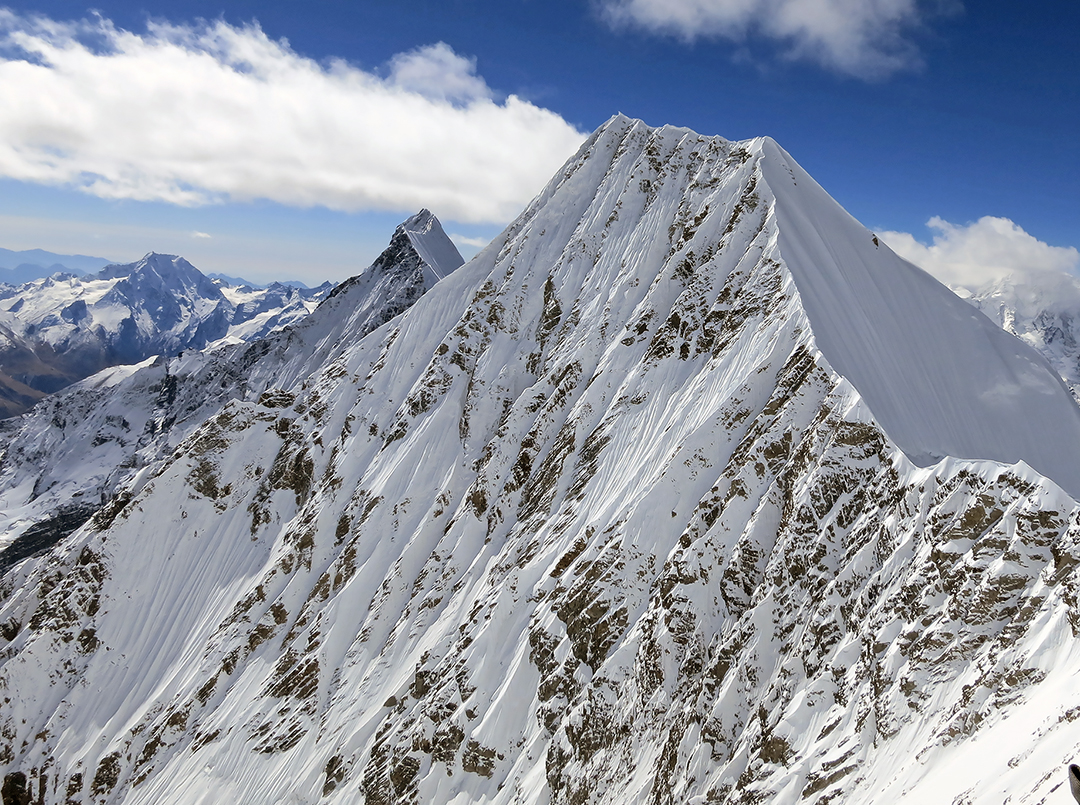Raksha Urai III (6,609m), southeast face, east ridge, and south ridg
Asia, Nepal, Far West Nepal, Api-Raksha Urai Himal

Christoph Kreutzenbeck and I left Kathmandu on September 25, 2012, for the Raksha Urai Range, with the intention of making a first ascent on one of the four Raksha summits, as designated by the 2001 British expedition (AAJ 2002). We flew to Nepalgunj, took a 20-hour bus drive to Chainpur, and then made a nine-day trek through the Seti Valley to establish base camp at 4,150m on a pasture east of Raksha Urai II and III. The military checkpoint in Chainpur informed us that we were the first Western travelers in this region since the French team that visited Raksha Urai in 2003 [though Americans were in this area in 2009—see below]. Far West Nepal appears rarely visited by Westerners and the infrastructure for trekking is still poor.
It was not possible to find additional porters, yaks, or mules for our expedition, and we could only buy food in small amounts during the trek. For these reasons, we were forced to take a few rest days at Dahachar (a.k.a. Dalachaur, 3,700m) while our Kathmandu porters returned from their first food carry. This delay meant that by the time we arrived in base camp on October 8, we had only 15 days left to climb.
Generally the weather was poor, with snow, wind and low cloud arriving in late morning, making our progress less rapid than expected. We first elected to try unclimbed Raksha Urai II (6,420m), exploring a route up the east flank to the north ridge. After a period of acclimatization and load carrying to our advanced base camp at 4,950m, and later to Camp 1 at 5,600m on the glacier between Raksha Urai II and III, we attempted Raksha Urai II on October 16. We left Camp 1 at 3 a.m. and climbed the east flank, to the south of the 2003 French line. We found 60–70° ice and mixed slopes, leading to deep, unconsolidated 70° snow ca 100m below the ridge. We reached the crest at noon, having caused snow slides. As the snow on the ridge above was still deep, we decided not to continue and regained Camp 1 at 5 p.m. On the 17th we retreated to base camp, and spent the 18th resting.

In continuing poor weather and with only a few days left, we switched our objective to Raksha Urai III and the 900m southeast face attempted by the British in 2001. On October 19 we reached Camp 1, and on the following day moved it as close as possible to the southeast face at 5,800m. We started out at 3 p.m. on the 21st, climbing 16 pitches of 60–70° ice of mixed quality to the east ridge, where once again we found deep, unconsolidated snow. We followed the crest to where it meets the south ridge, and then continued north ca 300–400m, crossing several false tops as reported by the French expedition, before reaching the highest point. The south ridge had been mostly snow-covered, with sections of loose rock.
We quickly returned to Camp 1, but had to rest there next day due to heavy snowfall. On the 23rd we regained base camp, and then walked out to Chainpur. There is still much climbing potential in this region, though it is remote and serious. More information can be obtained at mirjam.limmer@gmx.de or from our website at http://salon.io/mirjamlimmer/raksha-urai-expeditio...
Mirjam Limmer, Germany
Editor's note: The first expedition to visit the Raksha Urai Range was a 14-member Austrian team in 1997, which observed III to be the easiest of the group, but failed before reaching the south ridge due to heavy snowfall. An Austro-German team tried again in 1999, retreating from 5,950m. The leader and four other Austrians returned in pre-monsoon 2001, this time following a different line to the south ridge, but got no higher than 5,800m. At the time, confusingly, these expeditions referred to this peak as Raksha Urai IV, defining the group as having six peaks, and designating them, from south to north, Raksha Urai I to VI.
A mostly British team tried the southeast face in the post-monsoon season of 2001, retreating from ca 6,500m, just below the east ridge, in bad snow. However, this team was convinced that the Austrian Raksha Urai I was in fact called Dhaulagari (south top, 6,638m; north top 6,445m), separated from the remainder of the group by a large distance, and that VI was a ca 6,200m peak on the Tibetan border, some way east of the main range, and also felt to be a separate peak. The 2001 expedition therefore designated only four peaks in the Raksha Urai Range: I (6,370m), II (6,420m), III (6,609m), and IV (6,552m), a convention also adopted in 2003 by a French expedition. Four members of this expedition—Arnaud Clere, Catherine Coulaud, Gael Faroux, and Keshab Raj Gurung—made the first ascent of Raksha Urai III via the south ridge, but Faroux and Keshab Raj fell to their deaths during the descent. In 2009 Americans went up the Seti Khola as far as Garanphu, east of Dhaulagari, and climbed a 5,508m peak northeast of Korko, but did not visit the nearby Raksha Urai group.



